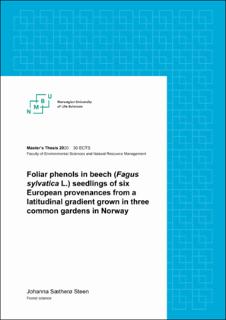| dc.contributor.advisor | Nybakken, Line | |
| dc.contributor.advisor | Asplund, Johan | |
| dc.contributor.author | Steen, Johanna Sætherø | |
| dc.coverage.spatial | Norway | en_US |
| dc.date.accessioned | 2020-08-19T11:06:50Z | |
| dc.date.available | 2020-08-19T11:06:50Z | |
| dc.date.issued | 2020 | |
| dc.identifier.uri | https://hdl.handle.net/11250/2672985 | |
| dc.description.abstract | With progressive climate change, the total concentration and composition of the chemical defense in European beech (Fagus sylvatica L.) is likely to change, which might impact its fitness and ability to establish beyond its current northernmost distribution limit in South-East Norway. In this master thesis, I aimed to explore the phenolic defense in European beech provenances grown in three Norwegian common gardens, and how the phenol concentration changed from the first to the second year after planting. The question whether the phenol concentration depends more on environment or genetics has so far been little studied.
The concentration of low molecular weight phenols in beech seedling leaves were analyzed using high-performance liquid chromatography (HPLC), whereas the condensed tannins were analyzed in an acid-butanol assay followed by spectrophotometry. I identified 19 low molecular weight phenols. I grouped the individual compounds into chlorogenic acid derivatives, quercetin 3-glycosides, kaempferol 3-glycosides, and calculated total flavonoids and total low molecular weight phenols. The explanatory power of the complete mixed linear model was about 50% for low molecular weight phenols as a group, and about 15% for the condensed tannins.
Environment (growing location) explained 5 % of the variation in total low molecular weight phenols, whereas genetic background (provenance) only explained 0.8%. Year explained most of the variation in low molecular weight phenols (31%). After the first year in the field, the northernmost growing location (Munkrøstad) had about 70% higher concentration of low molecular weight phenols than the southern growing locations, Ås and Re. The concentrations of methanol-soluble condensed tannins were 13% lower in Munkrøstad than in Ås and the methanol-insoluble condensed tannins were 33% lower in Munkrøstad than in Ås and Re. The mean concentration of total low molecular weight phenols was twice as high after the first year compared to the second year. After the second year, the differences between the growing locations were nonsignificant in many cases. I attribute the decrease in low molecular weight phenols from the first to the second year mainly to decreasing water and nutrient stress, as the root systems had had more time to establish and grow. My results suggest that intraspecific variations in concentration of phenolic compounds in beech are caused by differences in environment rather than genetic background, which may mean that changes in chemical defense with climate change will be faster. | en_US |
| dc.description.abstract | Klimaendringene fører sannsynligvis til at både den totale mengden og sammensetningen av kjemiske forsvarstoffer i bøk (Fagus sylvatica L.) forandres. Dette kan endre artens fitness og evne til å etablere seg nord for dagens utbredelsesgrense i Sør-Øst-Norge. I denne masteroppgaven var målet å utforske fenoler som bidrar til det kjemiske forsvaret i europeiske bøkeprovenienser i et proveniensforsøk på tre lokaliteter i Norge. Jeg undersøkte også hvordan fenolkonsentrasjonen endret seg i løpet av de to første årene i felt etter utplanting. Spørsmålet om hvorvidt fenolkonsentrasjonen styres mest av arv eller miljø har så langt vært lite studert. | en_US |
| dc.language.iso | eng | en_US |
| dc.publisher | Norwegian University of Life Sciences, Ås | en_US |
| dc.rights | Attribution-NonCommercial-NoDerivatives 4.0 Internasjonal | * |
| dc.rights.uri | http://creativecommons.org/licenses/by-nc-nd/4.0/deed.no | * |
| dc.subject | Fagus sylvatica | en_US |
| dc.subject | Phenols | en_US |
| dc.subject | Provenance trial | en_US |
| dc.subject | Common garden | en_US |
| dc.subject | Chemical defense | en_US |
| dc.title | Foliar phenols in beech (Fagus sylvatica L.) seedlings of six European provenances from a latitudinal gradient grown in three common gardens in Norway | en_US |
| dc.type | Master thesis | en_US |
| dc.subject.nsi | VDP::Matematikk og Naturvitenskap: 400::Zoologiske og botaniske fag: 480::Plantefysiologi: 492 | en_US |
| dc.description.localcode | M-SF | en_US |

